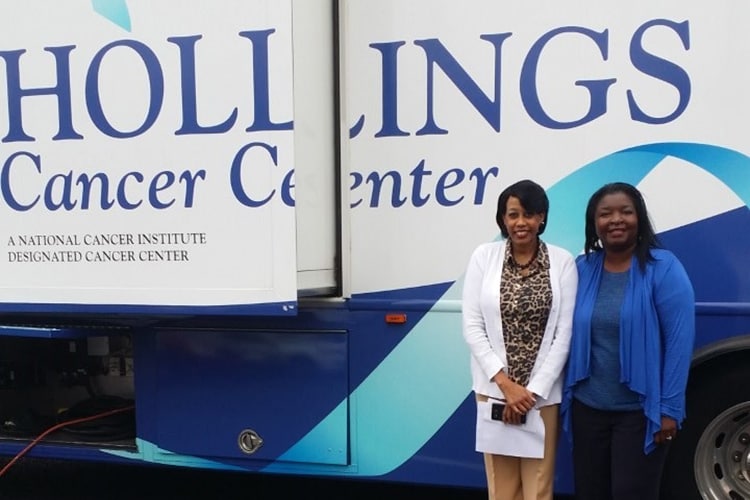South Carolina Reaches Women Through Diverse Partnerships

Dr. Trenessa Jones, Best Chance Network Program Director, and Stephanie Hinton, Cancer Division Director, at Hope Health in Williamsburg County in November 2016. This was the first joint mobile van screening for the Medical University of South Carolina and Clemson University.
In 1991, South Carolina was one of the first states to receive funding through the National Breast and Cervical Cancer Early Detection Program. Over the past 29 years, the state’s screening program, Best Chance Network, has screened about 135,000 women and found more than 1,600 invasive breast cancers, 550 pre-breast cancers, 1,100 invasive cervical cancers, and 3,200 pre-cervical cancers.
Using Data, the Program Reaches Women Through Partnerships
The Best Chance Network wanted to reach African American and Hispanic women. The program also wanted to increase the number of women who returned for routine screening. To address these issues, the program used data from the South Carolina Central Cancer Registry to decide where to focus its efforts. These data provide breast and cervical cancer incidence and death rates at the state, county, and ZIP Code levels.
The program worked with community organizations that had access to the populations they wanted to reach. To reach African American women, it worked with the South Carolina Witness Project, a faith-based organization that educates women on cancer risk factors and recommended cancer screening tests. Catawba Indian Nation and statewide non-federal Tribes were reached through the South East American Indian Council, Inc. The program worked with Closing the Gap in Healthcare to explain the importance of cancer screening at barber shops and beauty salons. The program also partnered with several large stores to host mobile screening events and set internal policies to encourage cancer screening. Rescreening rates in South Carolina increased from 46% in 2015 to 65% in June, 2020.
Patient Navigators and Focus Groups Identify and Remove Barriers
The Best Chance Network’s patient navigation program also contributes to this success. Internal and external staff address barriers that may prevent patients from getting recommended cancer screenings. The program works with community-based organizations to provide support services, including transportation, to patients who live in counties with high cancer incidence and death rates and low screening rates.
To expand its patient navigation reach, the program worked with AccessHealth Horry and Chronic Care Staffing to identify women who are one to three years overdue for screening so they can be linked to a medical home and resume cancer screening. Additionally, A.I.R. Consulting conducts annual focus groups with patients and providers to find out why patients may not get screened for cancer as recommended. Information from these sessions is used to improve provider training, and helps the program make decisions to serve more women.
Vans Bring Mammograms to Women in Prison and to Rural Areas
Many women were unable to get screened for breast cancer because hospitals closed in many areas. In 2019, the Best Chance Network partnered with mobile van providers to conduct 62 mobile mammography clinics throughout the state, screening more than 700 women. During one of these clinics, Best Chance Network partnered with the South Carolina Comprehensive Cancer Control Program and Invision Diagnostics to offer mobile mammography screening services to more than 1,300 women in the South Carolina Department of Corrections system throughout the state. The partners also helped the Department of Corrections develop processes for screening women in prison.
Provider Support Improves Follow-Up Care
The program also found that many women who had an abnormal test result didn’t return for follow-up care. In partnership with the South Carolina Office of Rural Health, the program worked with doctors throughout the state, including 87 doctors in rural areas, to improve their practices and reduce barriers. Every year, 40 health care providers in rural areas receive extra education and support. Health care providers throughout the state can participate in monthly webinars, online learning opportunities, and four annual regional trainings. The average time frame for receiving follow-up care improved from 6 months in 2017 to 10 business days in 2020.
The program continues to find ways to increase its reach. A partner organization, Leader’s Imago, coaches and supports health care providers throughout the state. The South Carolina Cancer Alliance, the state’s cancer coalition, offers mobile van mammography screenings through a faith-based program to reach women in their places of worship, and through a low-income housing program.
All of these efforts contribute to the program’s success. In fiscal year 2020 (June 30, 2019 to June 29, 2020), the Best Chance Network screened more than 14,000 women for breast and cervical cancer. That was 2,500 more women than projected despite COVID-19 challenges.